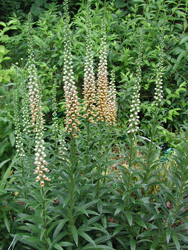Resource Library
Plant of the Week: Foxglove, Davis'
The University of Arkansas System Division of Agriculture does not promote, support or recommend plants featured in "Plant of the Week." Please consult your local Extension office for plants suitable for your region.
Plant of the Week
Davis' Foxglove
Latin: Digitalis davisiana

Most of our common garden plants originated in gardens years, and in many cases centuries, ago. These first-grown plants established a general sense of what the plant should look like and perform like in our gardens. But, as one who is always trying new plants, I wonder if maybe these earlier gardeners should have grown Digitalis davisiana before they decided for the rest of us what a foxglove should look like.
Digitalis davisiana is a perennial in the snapdragon family that, unlike the more common biennial D. purpurea, usually requires two or more growing seasons before the crown of basal leaves is sufficiently established to flower. Basal leaves are evergreen, shiny green and glabrous above and to 7 inches long. The leaves diminish in length up the stem.
In late spring and early summer the narrow, rocket-shaped scape grows to a meter tall, with willow-like leaves arranged up the stem. The yellow, marked-with-brown-veined flowers are bumblebee-sized, with a short tube about half an inch long, which is topped with a curved upper lobe that is about as long as the floral tube. Blooms open from the base of the spike upwards and continue to open over about a month-long period. The tiny seeds are produced in a small, many-seeded capsule.
I must confess this species is my favorite foxglove. It lacks the glitz for the more common, and larger flowered garden foxglove that blooms for me about a month earlier than D. davisiana. I prefer it because it has a more natural form than the oversized and overbred garden foxglove.
Davis' foxglove is not common in gardens; I received my seed from the seed exchange of the North American Rock Garden Society about 2002. It is named for Peter Davis (1918-1992), the botanical taxonomist who spent his career at the University of Edinburgh - where he worked for 30 years writing and editing the 10 volume Flora of Turkey, which was published as single volume additions between 1965 and 1988.
Davis collected the new foxglove during a 1948 trip in the mountains of southern Turkey, above the Mediterranean. He had developed an interest in Mediterranean flora during the two years he spent in Cairo serving in the British Army during WWII.
This wildling will never replace the long-established and admittedly showier common foxglove in gardens, but I still like it. It does best in a sunny border, where it should be grown in sufficient numbers so that the narrow spikes visually support one another. Planting clumps of 6 to 8 plants in a small area will provide the mass the plants need to be visually significant. The plants will tolerate overgrowth by nearby neighbors during their vegetative stage of development so long as the neighbor does not directly flop on top of the crown.
Once established, Davis' foxgloves have considerable drought tolerance. Though native to the Mediterranean, they are cold-hardy to zero degrees Fahrenheit and probably even colder conditions. For me, the plant has reseeded sparingly, but has shown no indication it is likely to escape cultivation.
By: Gerald Klingaman, retired
Extension Horticulturist - Ornamentals
Extension News - June 22, 2010
The University of Arkansas System Division of Agriculture does not maintain lists of retail outlets where these plants can be purchased. Please check your local nursery or other retail outlets to ask about the availability of these plants for your growing area.